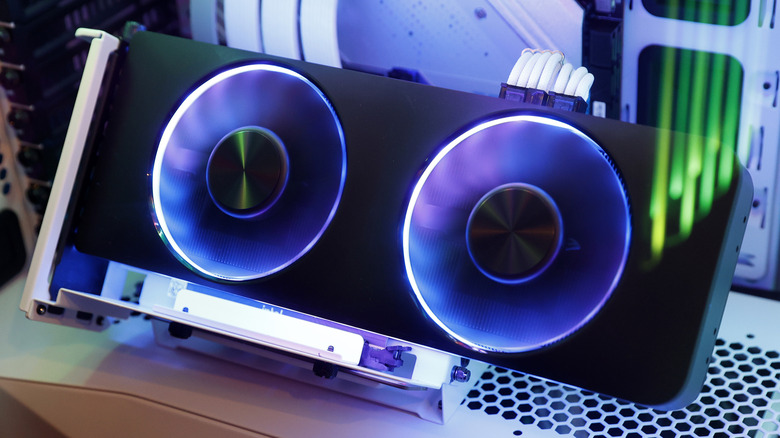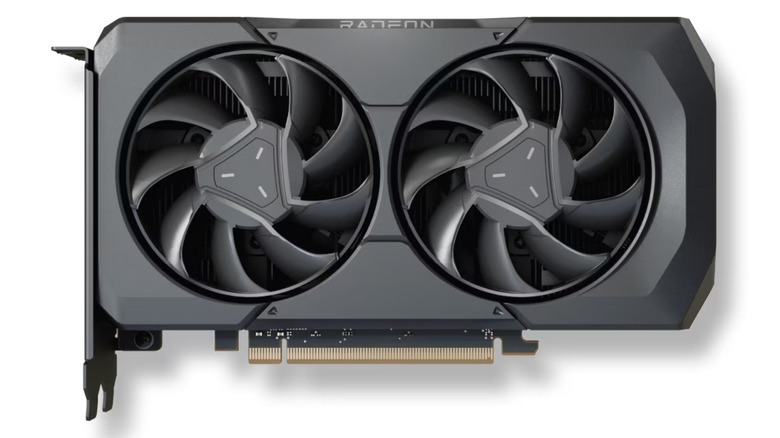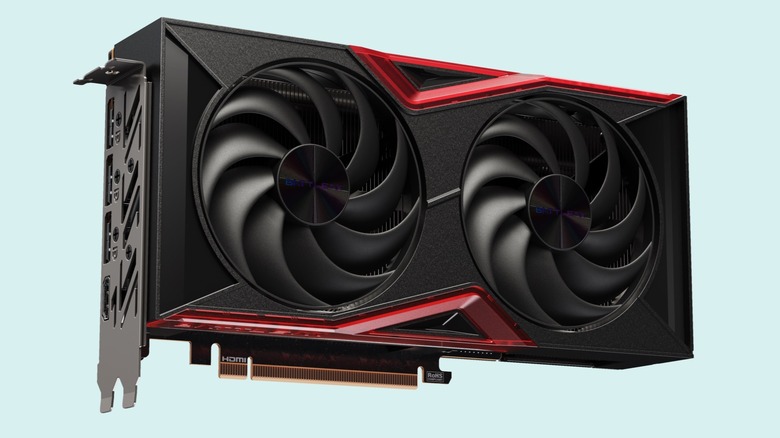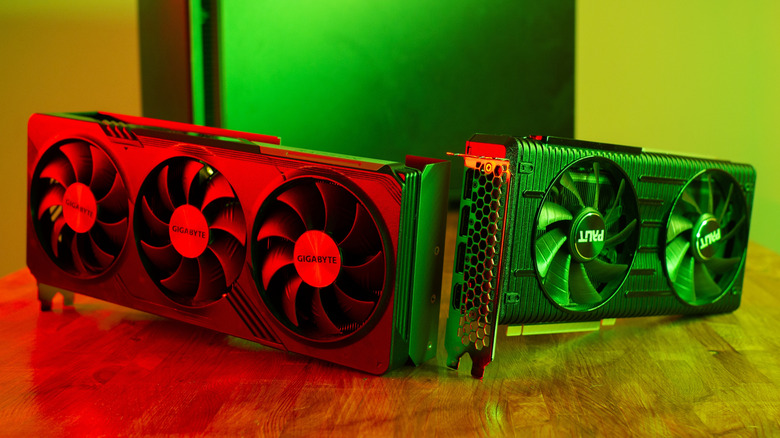3 Of The Best GPUs Under $300
When Nvidia revealed the RTX 5090 graphics card earlier this year, an asking price of $1,999 was less of a shock and more like a grim reality statement. The price hike trend is not exactly new, and neither is the supply crunch, but Nvidia quietly reiterated that graphics cards are now a dear investment. For folks on a budget, a current-gen GPU is a rarity. Additionally, it isn't a cakewalk finding an older GPU that could offer a decent balance of price and performance, especially if your budget can't cross the $300 mark.
That doesn't mean options don't exist, especially if you're averse to buying old and refurbished units. In fact, the entry-level is where you can stray away from Nvidia and still get a good value for the amount you part ways with. But before we dig into the options at hand, it's worth highlighting the compromises at hand. First, these cards are best suited for 1080p gaming at high or moderate graphics presets. You will also have to compromise on bells and whistles such as ray-tracing, textures, and realism in shadow renderings.
Down the line, you will find these budget cards in the "minimum" tier of game system requirements, instead of the "recommended" bracket, so keep that in mind. Also, we're zeroing down on the official MSRP, so the brand you go with might ask slightly higher than that.
Intel Arc B580
Who would've thought that Intel would pop up on a list talking about discrete GPUs, especially after the Larrabee debacle years ago? Well, the Arc graphics line, especially the Battlemage series, Intel has delivered a knockout punch. Announced at $249, the Arc B580 won nearly universal praise from experts for its fantastic piece-to-value ratio. Packing 20 Xe cores and an equal number of ray-tracing cores, this one eclipses the Nvidia competition by offering 12 GB of GDDR6 memory.
You get the usual 192-bit interface with an 8-pin design and support for core gaming stacks such as DirectX 12 and the in-house Xe Super Sampling (XeSS) tech for frame generation and upscaling. Intel claims that the Arc B580 can handle games at 1440p resolution and deliver north of 60fps, while the dual-encoder design is touted to speed up, by up to 81%, creative tasks such as video exporting. In the two months I spent with it, the Arc B580 proved to be a surprisingly solid option for budget gaming.
IGN regarded it as an "incredibly powerful graphics card at 1440p" for the asking price. The folks over at Tom's Hardware mentioned that it offers a better value for the price than AMD and Nvidia in the same price bracket. XDA-Developers gave it a 9/10 score, TechRadar awarded it a perfect 5/5 score, while PC Gamer praised the overall performance, but warned about driver inconsistency issues. Intel has slowly fixed the situation with the Alchemist line, so there's some hope with the Battlemage Arc B580 GPU improving down the road.
AMD Radeon RX 7600 XT
Ideally, I would recommend the AMD Radeon RX 7600 XT in this price bracket, even if you can find it used or refurbished for slightly lower than its MSRP of $329. I would even advise waiting for the new Radeon RX 9060 XT, which goes on sale next month at $299. But if your budget absolutely can't exceed the $300 limit, and you need a graphics card ASAP, the baseline AMD Radeon RX 7600 will serve you fine.
Carrying an MSRP of $269, the entry-level AMD GPU is targeted squarely at 1080p gaming, and even AMD is not making any ambitious claims beyond that. In titles such as "Apex Legends," "Call of Duty: Modern Warfare 2," "Fortnite," and "Overwatch 2," the company is promising above 100FPS, while titles such as "Resident Evil 4," "Star Wars Jedi: Survivor," and "Hogwarts Legacy" should run above the golden 60FPS level.
Reviews, however, have been somewhat of a mixed bag. Tom's Hardware gave it a score of 3.5/5, praising its solid 1080p gaming chops for the asking price, though it doesn't break any new ground in terms of innovation or even generation-over-generation upgrades. At PCMag, it landed at a score of 4/5, winning praise for its consistent gaming output as a "1080p workhorse value card." PC World gave it an identically high rating, while TechSpot noted that the AMD Radeon RX 7600 is hard to recommend at $270, but could be a winner at a lower sticker price.
Nvidia GeForce RTX 5060
The latest from Nvidia has just landed on the shelves and will set you back by $299. This is the MSRP we're talking about, so if you want options with snazzy RGB or overclocking, prepare to pay a tad higher for the custom variants sold by add-in card providers. Nvidia says its latest entry-level card offers double the performance compared to its direct predecessor with the DLSS 4 tech enabled.
At games, the company is touting a 100FPS+ outing in titles such as "Cyberpunk 2077,"Doom: The Dark Ages," "Far Cry 6," "Shadow of the Tomb Raider," and "God of War: Ragnarok." DLSS 4, which can generate up to three new frames per natively rendered frame, is being pushed as the big draw for this one, while hawking a library of over 100 games that support this perk. This Blackwell generation graphics card upgrades the Tensor and ray-tracing cores compared to the Ada Lovelace RTX 4060 series cards, while also offering a much higher memory bandwidth and shifting to the faster GDDR7 module.
Reviews, however, have been polarizing. TechSpot called it "effectively a discounted RTX 4060 Ti." EuroGamer's analysis notes that it can match console performance, but the VRAM situation is stingy. RockPapersShotgun labelled it as a passable GPU, but highlighted game driver issues. However, before you decide to splurge or pass on it, you might want to wait for more outlets and independent analyses to come out, as Nvidia has reportedly embroiled itself in a PR disaster regarding reviews.
How we picked our GPU recommendations
The three desktop GPUs listed above were picked after my own testing and reviews sourced from experts in the tech and games journalism community. The top two cards on the list were sourced from ASRock, specifically the ASRock Intel ARC B580 Challenger and the Asrock AMD Radeon RX 7600 XT Steel Legend. The test bed was powered by an octa-core AMD Ryzen 7 9700X CPU that goes up to 5.5 GHz peak frequency, linked to 32GB of RAM.
The performance was tested using a mix of synthetic benchmarks as well as AAA games. For synthetic tests, I ran Blender rendering and 3DMark tests, while gaming prowess was tested using in-game benchmarks and actual gaming performance. I kept the gaming tests limited to 1080p and 1440p resolutions, as these cards are primarily targeted at this bracket. Games that we tested included a mix of new and old titles.
Depending on the title at hand, I ran games mostly at medium and high presets, adjusting the graphics quality where ray-tracing was available. As far as the games go, I primarily played Cyberpunk 2077, Forza Horizon 5, Tomb Raider, Horizon Zero Dawn, Star Wars: Jedi Survivor, and Dying Light 2 Stay Human. I am yet to get my hands on the Nvidia GeForce RTX 5060, but made the pick based on its price and performance testing by veterans in the games journalism industry.




